PASW Regional Newsletter: Spring 2008
Focus On Current Projects
Working in Plymouth
For over a year now I’ve been working with Plymouth City Council Planning department in a position funded by a CABE Project grant. My role has been to examine how best they can maximise the potential for public art, particularly with the large number and scale of private developments proposed or in the pipeline; to set up best practice ways of working with artists and to ensure that work commissioned is suited to its location and of the highest quality and to look at a city-wide strategy for art in the public realm with a particular focus on the waterfront.
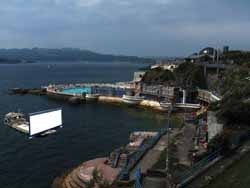
Digital collage image for proposed film
projections off Plymouth Hoo
Photo: Tim Knowles
I’ve worked directly with planning officers, informing and educating them about the wide range of possibilities for art in the public realm, the different forms it can take and best practice in terms of commissioning. As part of this process Jonathan Banks [Chief Executive of ixia] and I did a joint presentation to planning officers, looking at our experiences of working together in Bristol [when he used to be public arts officer] and his work now with ixia.
A section of supplementary planning guidance was devised for public art, setting out best practice, the various options and approaches that a developer might take, and a flow chart taking them step by step through the process as a whole, setting out milestones and deadlines particularly with regard to developers’ Section 106 obligations.
My role has also included guidance on budgets and approaches for public art within certain proposed developments and advice on the short listing of artists for interview, at times sitting in on interviews as an artist member of the panel. Having an artist on any public art interview panel is I feel vital, presenting an artist’s view point and understanding of the way in which artists think and work.
I have also been working with Plymouth Art Centre who is a key player within the city, and have been very actively working outside the confines of the gallery on a number of projects with artists in the wider city.
The work has so far been quite bureaucratic, networking, communicating, informing and putting systems in place for the future. The plan now is to work in a more creative way, instigating some temporary projects around the waterfront.
Tim Knowles, [email protected]
Take A Part - The Efford art programme
The Efford art programme that began as part of a master planning process in 2006, continues to work as an integral part of the area’s regeneration through the South West Regional Development Agency funded Building Communities Initiative.
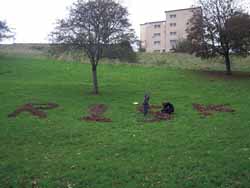
Young people, risk, and a green space
Photo: J. Murray
Taking a ground-up approach, the programme relies on the participation of residents to shape the regeneration process - central to the programme is a valuing of Efford experience. Perhaps uniquely, the regeneration does not focus solely on changes to the physical environment, but also engages with the social situation. The themes previously identified as significant to the area of local food, use of public space, heritage, and connectivity are being developed further through a series of projects. Currently underway are ‘Efford Valley Sides’ an exploration of an underused space, and ‘The Ward Place Roundabout Project’, the redesign of a streetscape with residents by Jayne Murray. ‘Grow Efford’ with Anne-Marie Culhane is a mapping of local growing, communal harvesting and distribution. Outcomes of these and future projects will inform the development of Efford’s many green spaces. The programme is supported by the Heart of Efford Community Partnership, Plymouth City Council and Plymouth Arts Centre, the Public Health Development Unit, Youth Services, PETRA and local schools.
Jayne Murray, [email protected]
Devonport
Plymouth is one city created by three towns, Plymouth, Stonehouse and Devonport. Home to the largest Naval base in Western Europe, Devonport has hosted the Royal Navy since the 17th century. Despite its historical significance – Charles Darwin’s Beagle is but one of many famous vessels that have sailed from this port - Devonport has suffered decades of economic decline. In response, Central Government named Devonport as one of 39 recipients of major grant funding through the “New Deal for Communities” programme.
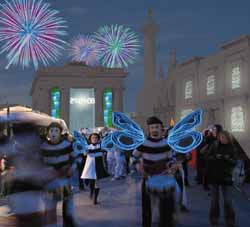
Proposed Devonport Festival
Photo: Donna Jones
Dispersal of NDC funds is the responsibility of Devonport Regeneration Community Partnership. As part of their long-term strategy for managed, thoughtful regeneration, DRCP commissioned a comprehensive Arts Strategy from Denna Jones in October 2007. The Strategy covers the inclusion of art, architecture and design within the diverse regeneration package that includes elements of the redesign of Devonport Park; three major new housing developments (one of which includes the conversion by Firmac Developments of historic Admiralty House into a hotel), and a Resident Curator scheme. These areas will be linked on a “Blue Green Route” that arcs through land and sea and highlights an innovative “heritage trail” that will include functional redesign and rediscovery of Devonport’s significant history and built environment heritage.
Denna Jones, [email protected]
Krowji Development Programme
The major redevelopment of the Krowji studios complex based at the former Redruth Grammar School site in Cornwall is now well into its second stage design process with consultations taking place between the architects and local planning authorities prior to submission of the planning application for the proposed £4 million rebuild. Cornwall Arts Centre Trust, the organisation leading the scheme, worked closely with PASW to appoint a Consultant Artist to work as part of the design team as soon as the architects were chosen following a national competition. The appointment of Paul Ridout to this role in July 2007 has led to a series of brokered meetings between the core design team and the users of the buildings resulting in a dynamic ‘sketchbook/wall’ to which everyone is encouraged to add comments and observations to help shape the design process.
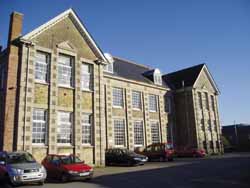
Old Grammar School, Redruth
Photo: Tanya Griffiths
The design team and project leaders have now visited 11 different studio/workshop complexes around the country and talked with their users, designers and managers, a very helpful exercise that is giving us an insight into the necessities and pitfalls of studio/workshop provision.All manner of buildings and work solutions were on view and it served to underline our understanding that everyone has a different requirement, but that given a workable starting point everybody was able to adopt, adapt and create.
Paul Rideout & Ross Williams, [email protected]
Groundwork SW
Although my post as Strategic Arts Coordinator technically covers the whole of the South West region, the reality is that at this early stage much of my focus is almost inevitably on Plymouth. This is mainly geographical practicality, as the majority of Groundwork’s staff (including me) is based there – and over a period of more than 10 years, Groundwork has completed numerous projects in the city. Charged with the task of facilitating and embedding high quality contemporary arts practice within our organisation and its projects, it seems natural to at least start with the situation at hand. Our current (and first) Artist in Residence Clare Thornton has been working with our staff, sharing her working practice whilst engaging in theirs, and it feels like the most fantastic way to start on what is an ambitious road for Groundwork.
Through involvement with PVAC (what is this?), and by developing future commissioning collaborations, we hope to establish a diverse and dynamic way of working. This will then be the model with which to tackle other places, other environments and challenges. Our aspiration, put simply, is for Groundwork to be considered one of the best commissioners of contemporary art working in the public realm. Eventually.
Ray White, [email protected]
The Architecture Centre Devon and Cornwall
The Architecture Centre Devon and Cornwall was established in June 2006 with support from CABE - the Commission for Architecture and the Built Environment and Creating Excellence, the regional centre for sustainable communities, to promote quality in the design of the built environment. With an administrative base in Plymouth, the centre works towards raising public awareness of design issues and supporting local authorities in achieving high design aspiration and outcomes, through design review, project work, events and exhibitions.
ACD&C can provide guidance on design advocacy, information for commissioners of building projects, design champions and local authorities looking for support and resource. The centre can draw on expertise to advise on design review, design procurement and public consultation and to deliver urban and architectural design workshops.
ACD&C is also working with the Architecture Centre Bristol, to deliver an education programme and inspiring young people to engage in the design of their built environment across the South West region.

I love buildings logo
Designed by two, www.twodesign.co.uk
To find out more, visit the website launched in December 2007, Architecture Centre Devon & Cornwall. News and events are regularly updated, there are activities for children and adults and registration for newsletters.
Tanya Griffiths, [email protected]
Reap Lighting Project
Redruth is a town rich in “architectural gems”, but has suffered greatly with the demise of mining and trading in general. The Urban Regeneration Company (URC) and the RDA see the future for the town as a cultural quarter, building on its assets with the development of the Old Grammar School (Krowji) as a centre for arts and culture, the Cornwall Centre (family history archives) and the proposed Heritage Centre. Redruth Educational & Economic Arts Partnership (REAP) has been working on a lighting project to compliment this.
The idea originally stemmed from the fact that Redruth has the first house in the world to be lit by coal gas. William Murdoch, the inventor of gas lighting, lived in Cross Street for approx. 20 years and lit his workshop, in the cellar, by gas, circa 1792 AD. Over the next 20 years towns & cities all over Europe introduced street lighting which had a dramatic effect on society. We started in January 2007 with a feasibility study, contacting owners, developers and lessees. With the help of a lighting consultant living locally who volunteered his time, we were able to offer free proposals on individual LED lighting schemes and the cost of maintenance. A fantastic response has led to a pilot project on two premises, with the coordination of the County Council, Kerrier District Council and the owner, being completed in March.
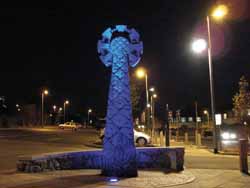
Celtic Cross in New Cut car park at night
Photo: Keith Dinham
Redruth Town Council has agreed to a proposal for their chambers and St. Rumons Gardens is being colour washed and features spot lit. The Town Clock will be finished this year with colour changing on the clock face and tower. We have made presentations to the Heritage Economic Regeneration Scheme (HERS) and Kerrier District Council for funding and will be looking to the RDA to match fund.
We have had enthusiastic support from PASW, who have conducted a survey and produced a report from Mark Luck Associates and match funded our lighting consultant for more detailed work.
We have set ourselves a timescale of two years to complete the project – (pretty ambitious!!) with approximately 33 buildings on Phase I & II. The aim is to subtly light the interesting features as a background scheme throughout the main street and access roads. With the successful securing of £37.5k from the District Council which we are hoping to match, the project can really get started.
Anne Pascoe, [email protected]
Weymouth and Portland public art commissioning plan for 2012
These are exciting times for Weymouth and Portland as the only venue outside London to host the 2012 Games. The sailing events will take place at the National Sailing Academy in Weymouth and Portland and sailing teams will also be visiting regularly to practice in the years leading up to 2012. As the eyes of the world turn to Weymouth and Portland in 2012 it will have the huge responsibility of representing Dorset and the South West region to the world. That is one of the reasons why a public art strategy was commissioned, in order to ensure that Weymouth and Portland will project an image of a creative, dynamic, forward looking and culturally rich place.
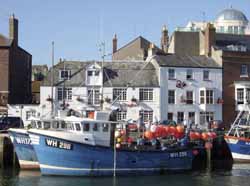
Weymouth Harbour
Photo: Simon Fenoulhet
Since September 2007 the consultants, Mererid Velios, Simon Fenoulhet and Geoff Wood have researched the area in terms of opportunities for public art within regeneration and development schemes and consulted with individuals and organisations to develop a draft strategy which was presented before Christmas to the steering group. Themes were suggested to highlight what Weymouth and Portland have to offer and to maximise legacy outcomes from 2012. With the Jurassic Coast and inspiring young people as overarching themes, the sub themes include ‘Animate and humanise public spaces’, ‘Tourism and regional image’, ‘Olympic Celebrations’, ‘Focus on Sustainability’, and ‘Centre of Marine Excellence’. A final strategy is now being considered by the steering group and further news about how the strategy will be taken forward and implemented will be available soon.
For further information contact Alan Rogers, Arts Development Officer, [email protected]
